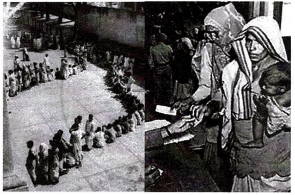Advertisements
Advertisements
Question
Answer the following question.
The first General Election in India (1952) was a landmark event in the history of independent India. Discuss.
Solution
India’s first General Election of 1952 became a landmark in the history of democracy all over the world.
The following were the features of general elections of 1952 :
- The elections took place according to the new constitution. The success reflected the faith of the Indian leaders in a democracy.
- In spite of having a largely illiterate population, Jawaharlal Nehru had granted voting rights to all the adults through Adult Franchise.
- Sukumar Sen, the first Election Commi¬ssioner of India, along with 10 lakh government officials managed the entire election process with great care and caution.
- 14 national parties, 53 regional parties and numerous independent candidates contested for 489 Lok Sabha and 3283 State Assembly seats. 98 Lok Sabha seats and 669 Assembly seats were reserved for the Scheduled Castes and Scheduled Tribes.
- Congress won with a huge majority with 75% seats in Lok Sabha and 68.5% seats in State Assembly. It had got an absolute majority in most states except Madras, Travancore-Cochin, Orissa, and PEPSU. It also formed a coalition with smaller parties and independent candidates and formed government in few states. There was no tradition of any leader of opposition then.
- The next winning party was the Communist Party of India and its allies. It won 23 seats in the Lok Sabha and 147 seats in the Assembly.
- Jan Sangh, Hindu Mahasabha, and Ramrajya Parishad won only 10 seats in the Lok Sabha.
- Besides the above-mentioned parties, former royals and big landlords performed well in certain regions of the country.
- In spite of achieving absolute power, Congress followed democratic norms and encouraged the development of democratic ideals in the nation. The Opposition leaders participated in debates and gave constructive feedback for government policies.
- Full freedom was enjoyed by the press, the political parties, trade unions, and other organizations. They could voice their opinions.
- Several leaders, such as Dr. Shyama Prasad Mukherjee, Rammanohar Lohia, J.B. Kriplani, A.K. Gopalan, etc. shared their valuable ideas on the working of the Central Government.
APPEARS IN
RELATED QUESTIONS
The first General Election in India (1952) was a landmark event in the history of independent India. Discuss.
Mention the principle on which the first general election in India (1952) was based.
The first General Election in India in 1952 was based on the principle of ______.
With reference to the image shown below, explain the results and the significance of the First General Elections in India in 1952.

The first Lok Sabha election was held on the principle of ______.
